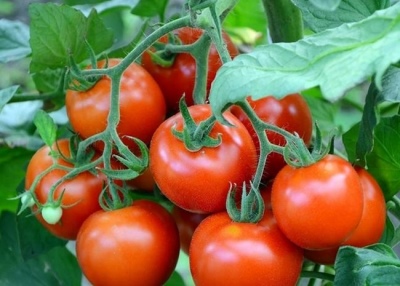
- Authors: Gavrish S.F., Morev V.V., Amcheslavskaya E.V., Volok O.A., Gavrish F.S.
- Year of approval: 2012
- Category: hybrid
- Growth type: indeterminate
- Appointment: fresh consumption
- Ripening period: mid-season
- Ripening time, days: 103-108
- Growing conditions: for film greenhouses
- Transportability: Yes
- Leaves: large, dark green
Tomato Dobry fully lives up to its name. This mid-season variety produces a large number of fruits and is excellent against many diseases.
Breeding history
The development of culture was carried out in the "Gavrish" firm. The project was handled by a group of specialists: Gavrish, Morev, Amcheslavskaya, Volok. The official admission for cultivation in vegetable gardens was given in 2012.
Description of the variety
Tomato Dobry is one of the indeterminate hybrids. Its official description says that this crop should be grown in greenhouses under film. The leaves of the plant are very large. They are typically dark green in color.
The main qualities of the fruit
The earliest berries are light green in color. A simple green spot appears at the base. While ripening, the tomatoes turn red. Other parameters:
- the weight is from 0.13 to 0.17 kg;
- configuration - flat circle;
- development on a simple inflorescence;
- the peel is smooth;
- articulated stalk format.
Taste characteristics
The Good Tomato can be eaten fresh. The harvest is characterized by a decent keeping quality. The taste is ordinary, more sweet, since there is a lot of sugar in the fruits.
Ripening and fruiting
This is a typical mid-season crop. The formation of the crop requires 103-108 days. The countdown starts from the very first green growth.
Yield
The collection is quite large. It can be from 10 to 13.5 kg per 1 m2. The amount of the harvest is influenced by both the weather and agricultural technology.
The timing of planting seedlings and planting in the ground
Growing a Dobry tomato is possible only by the seedling method. It is necessary to sow seeds about 60 days before the time of the proposed transplantation into open ground. Store-bought seeds are usually ready to go. However, occasionally they still have to be soaked. Recommendations:
- after pecking the first shoots, it is necessary to increase the daylight hours to 16 hours;
- further 14 days, seedlings should develop in a warm, bright place;
- the transfer of tomato bushes to greenhouses should be done at the end of April;
- they are kept there for 10-12 days in order to achieve full hardening;
- between the dive and landing at a permanent place should pass about 30 days.

Growing tomato seedlings is an extremely important process, because it largely depends on whether the gardener can harvest at all. All aspects must be taken into account, from seedbed preparation to planting in the ground.
Landing scheme
The gap between the holes can be 50 or 60 cm. Often they write about the need to choose a 60x50 cm system. It is inappropriate to use any other methods.

Growing and care
Dobry bushes can be cultivated in loose soil with optimal drainage. The systematic pinching of plants plays an important role. Thickening of plantings is extremely critical. The bushes will have to be tied up constantly. It is recommended to use tapestries for this procedure. Greenhouses should be ventilated as thoroughly as possible.
The appearance of weeds is also extremely dangerous for a greenhouse culture. They need to be weeded as often as possible. During the growing season, you will have to feed the plant at least 3 times. You need to feed the tomato with nitrogen only before flowering. Fertilizers are in any case put in the morning hours, and after watering.




A plant needs different micronutrients at each stage of growth. All fertilizers can be divided into two groups: mineral and organic. Folk remedies are often used: iodine, yeast, bird droppings, eggshells.
It is important to observe the rate and period of feeding. This also applies to folk remedies and organic fertilizers.
Disease and pest resistance
The declared ability of the Dobrogo tomato to successfully resist:
- cracking of the fruit;
- fusarium wilting;
- tobacco mosaic.


Growing regions
The variety was zoned for the Far East and the Moscow region. It can also give good results:
- on the banks of the Volga;
- in the Urals;
- in the north of the European part of Russia;
- in the middle lane;
- in various regions of Siberia.
Review overview
Some gardeners note that late blight often interferes with ripening in open ground. But indoors, the culture will develop well. There are quite a lot of fruits, especially in sunlit areas. Dobry's berries look pretty pretty. There are no special problems when growing them.

























































































